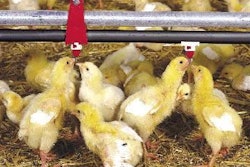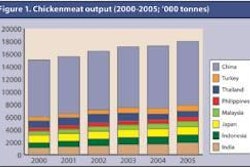The highly pathogenic strain of the avian influenza virus – H5N1 – appeared to come from nowhere to infect a huge turkey farm in eastern England. No infections had been reported before or since in the UK’s wild bird testing programme, and the nearest poultry outbreaks were in geese at Szentes in the Csongrád region of southern Hungary.
Government ministers immediately blamed migratory birds for introducing H5N1 into the United Kingdom (UK). Wild water fowl they said provided infected faeces for introduction by small birds, bedding or workers into one of the most biosecure poultry units in the country. This belonged to the multi-national Bernard Matthews Company, which farms turkeys and processes poultry at the Suffolk site.
Bernard Matthews has poultry farms and processing plants in Hungary but they and UK government including Department of Environment, Food and Rural Affairs (DEFRA) dismissed any connection, emphatically saying UK and Hungarian operations were totally separate with no trade between.
Subsequent investigation by The Guardian newspaper and others elicited the truth, the UK government was forced to admit a Hungarian connection and scientists began to investigate. All the skills of Sir Arthur Conan Doyle’s Sherlock Holmes – England’s most famous fictional detective – will be needed to unravel the paper trail leading up to this outbreak.
Genetic sequencing cannot lie
Genetic sequencing gave the vital clue. European Union laboratories rapidly confirmed sub-type as H5N1, and subsequently sequenced genes to reveal a strain identical to the one in Hungarian geese. A dynamic virus like highly pathogenic H5N1 is unlikely to travel unchanged on a relay of wild birds from Hungary to England. Results of gene sequencing suggest a more rapid and direct mode of transfer, initiating a series of questions to the Government and Bernard Matthews.
Senior government ministers including Lord Rooker (Agriculture Minister) and David Miliband (Environment Minister) had said there was no movement of live birds or eggs from Bernard Matthews’ Hungarian farms into the UK. But they forgot to mention partly processed fresh turkey (skinned and deboned breasts) that had been delivered there from the Bernard Matthews subsidiary, SaGa Food Zrt in Hungary. Thirty eight tonnes arrived weekly for final processing on the same Holton site adjacent to the 22 turkey houses. One consignment had arrived a few days before 27 January, the date when the first turkeys became sick and died.
Bernard Matthews then revealed that the SaGa Food complex was at Sàrvàr in northern Hungary – more than 250km from the outbreaks in geese. They did not mention a second slaughterhouse at Kecskemét in southern Hungary just 20km from the restriction zone around the outbreak farms.
How did the infection reach the farm?
Migratory wildfowl may or may not have introduced H5N1. The Deputy Chief Vet, Fred Landeg, first claimed they had but later expressed doubts. If H5N1 was imported onto the Holton site on fresh poultrymeat from Hungary, how did it penetrate enclosed poultry houses next door, which Bernard Matthews said exceeded UK government requirements for biosecurity?
One obvious answer is from infected waste material from the processing plant left outside where scavengers including crows, gulls, rodents and foxes picked up H5N1 infection. According to the The Times newspaper, DEFRA vets found in a pile of processed poultry waste outside the plant. Off-cuts and a label confirmed connection with the slaughterhouse at Kecskemét in Hungary.
H5N1 virus particles can survive intact for 35 days at 4ºC, which is the average daytime temperature for eastern England at this time of year. Refrigerating or freezing lengthens the virus survival period.
H5N1 could have entered the poultry houses on wild birds through a ventilation shaft or on workers’ footwear. The possibility of virus introduction by workers moving from the processing plant to the farm needs to be ruled out, as does the unlikely but possible direct introduction by Hungarian workers. Most of the workforce at Holton is migrant workers but the majority are Portuguese.
The Blame Game and a loss of consumer confidence
The UK government clearly hoped the episode would blow over and it did for 24 hours as the last of 160,000 turkeys were culled and until The Guardian made public the Hungarian connection.
In the meantime, packaged turkey meat from the Suffolk plant continued to be distributed for sale and consumption throughout the country. If infected meat did arrive at the plant from Hungary, it could already be in the UK food chain.
Government Chief Scientist, Professor Sir David King, has suggested that all packaged turkey meat originating from the plant may have to be recalled from supermarkets. Creating confusion as the Foods Standards Agency (FSA) told the press they had no plans to recall turkey products.
Up to this point, sales of turkey and other poultry product held up well with UK consumers apparently hardened by previous food scares. However, supermarket chains have claimed sales of poultry and especially turkey products were starting to fall by up to 10 percent.
What next?
British poultry producers, custodians of a £3.4 billion industry, are extremely worried. The National Farmers Union (NFU) has demanded a ban on all imports of raw poultry from H5N1-affected countries until the outbreak source is clarified. ‘Green’ lobbyists have started sniping at the industry. As well as blaming H5N1 on intensive farming, Caroline Lucas (Green Party Member of the European Parliament ) called for an EU-wide moratorium on international trade in poultry.
Government ministers and Bernard Matthews stand accused by the media of withholding information. The latest disclosure reveals that consignments of raw poultrymeat arrived at the Holton plant from the suspect Hungarian slaughterhouse as recently as three days after the UK outbreak.
The Environment Minister was forced to make a public statement. He reported that DEFRA vets had said to ban shipments was unnecessary and that government’s hands were tied by EU regulations. EU regulations forbid the movement of poultry within 30km of an avian ‘flu outbreak. The Hungarian slaughterhouse was just outside that zone.
Biosecurity appears to have been ineffective at the processing plant and farm in Suffolk, especially since vets now say infection was not confined to one poultry house. Tests showed three other houses contained infected flocks, although affected birds appeared healthy.
Bernard Matthews Company was the undisputed king of turkey farming, processing and marketing in the UK. It pioneered the business and brought hitherto out-of-reach turkey products to millions of consumers. Now things do not look good for the £400 million international business.


















